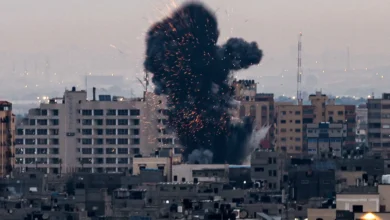A ‘cultural genocide’: Which of Gaza’s heritage sites have been destroyed?

An ancient harbour dating back to 800 BC, a mosque that was home to rare manuscripts and one of the world’s oldest Christian monasteries are just a few of at least 195 heritage sites that have been destroyed or damaged since Israel’s war on Gaza began on October 7, according to an NGO documenting war damage on cultural sites.
Wiping out the cultural heritage of a people is one of the many war crimes South Africa alleges against Israel in a lawsuit that was heard this past week at the International Court of Justice. It states: “Israel has damaged and destroyed numerous centres of Palestinian learning and culture”, including libraries, religious sites and places of ancient historical importance.
Gaza, one of the world’s longest inhabited areas, has been home to a pastiche of people since at least the 15th century BC, according to historians.
Empires – including the ancient Egyptians, Assyrians and Romans – have come and gone, at times dominating the land of the Canaanites, the ancestors of the Palestinians, leaving relics of their own cultural heritage behind. Greeks, Jews, Persians and Nabateans have also lived along this stretch of coast over the centuries.
Strategically located on the Mediterranean’s eastern shores, Gaza was always in a prime position on the trade routes from Eurasia to Africa. Its ports made it a regional hub for commerce and culture. Since at least 1300 BC, the Via Maris – a route running from Heliopolis in ancient Egypt, cutting across Gaza’s western coastline and then crossing into Syrian lands – was the main route that travellers would take on their journeys to Damascus.
“The crime of targeting and destroying archaeological sites should spur the world and UNESCO into action to preserve this great civilisational and cultural heritage,” Gaza’s Ministry of Tourism and Antiquities said after Gaza’s Great Omari Mosque was destroyed in an Israeli air strike on December 8.
As a result of that particular strike, an ancient collection of manuscripts kept at the mosque may be forever lost. “The manuscript collections remained in the vicinity of the mosque and are currently inaccessible because of the continuing conflict,” Columba Stewart, the CEO of the Hill Museum and Manuscript Library (HMML), told Al Jazeera soon after the strike.
The 1954 Hague Convention, agreed to by both Palestinians and Israelis, is supposed to safeguard landmarks from the ravages of war. Isber Sabrine, president of an international NGO that documents cultural heritage, explained that crimes affecting cultural heritage are part of the “collateral damage of genocide”.
“Libraries serve as cultural repositories, and attacking them is an attack on cultural heritage. What is happening now is a war crime. It goes against the first Hague convention,” Sabrine said. “Israel is trying to erase the connection of the people with their land. It’s very clear and intentional. Gaza’s heritage is part of its people, it’s history and their connection.”While cultural genocide erases tangible heritage like museums, churches and mosques, intangible heritage includes customs, culture and artefacts. These, too, have been damaged, including the Union of Palestinian artists on Jalaa Street in Gaza City and the well-known clay pots once baked in the city’s al-Fawakhir district.
In a statement to Al Jazeera, UNESCO said: “While priority is rightly given to the humanitarian situation, the protection of cultural heritage in all its forms must also be taken into account. In accordance with its mandate, UNESCO calls on all actors involved to strictly respect international law. Cultural property should not be targeted or used for military purposes, as it is considered to be civilian infrastructure.”









